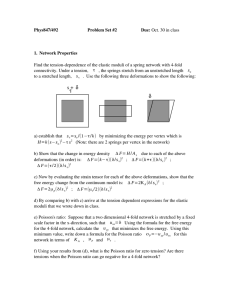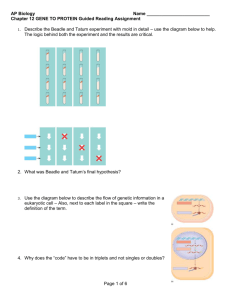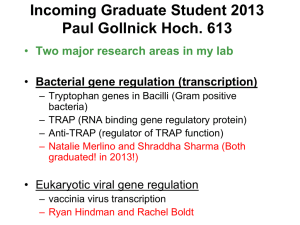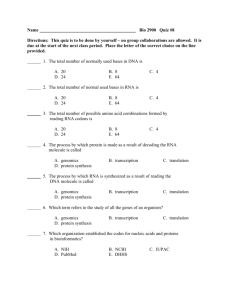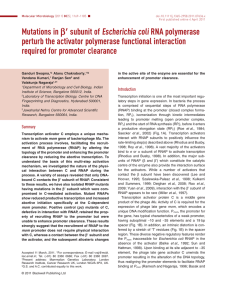Physics 347 Assignment #3 Due Oct 23 (in class) Reading:
advertisement
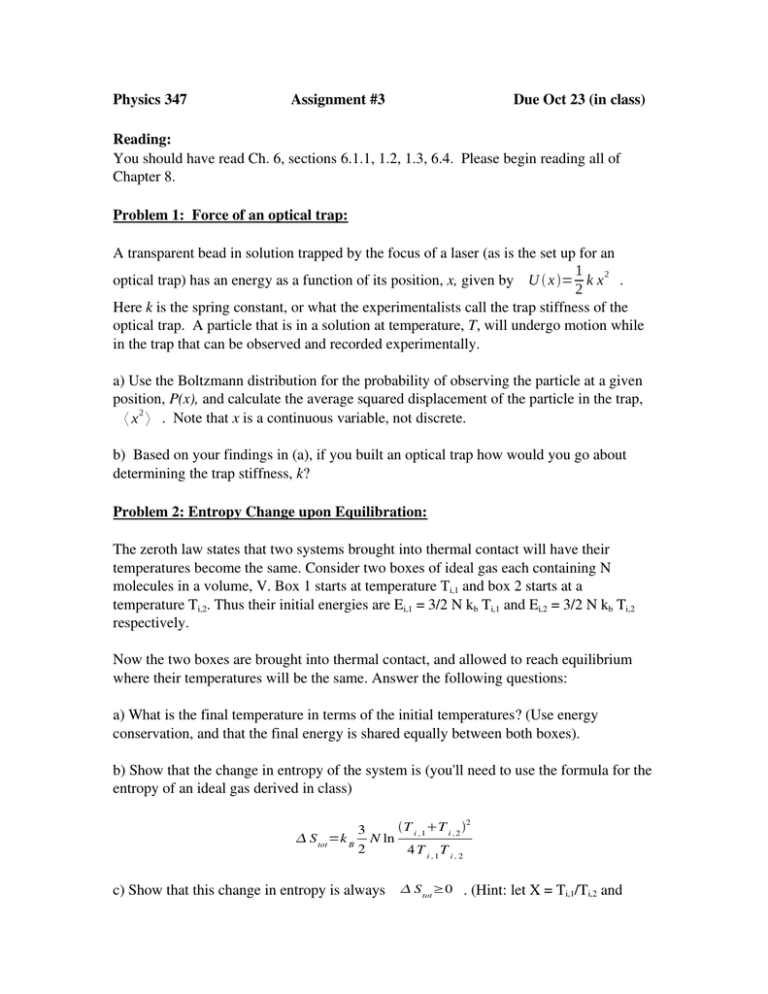
Physics 347 Assignment #3 Due Oct 23 (in class) Reading: You should have read Ch. 6, sections 6.1.1, 1.2, 1.3, 6.4. Please begin reading all of Chapter 8. Problem 1: Force of an optical trap: A transparent bead in solution trapped by the focus of a laser (as is the set up for an 1 2 optical trap) has an energy as a function of its position, x, given by U x = k x . 2 Here k is the spring constant, or what the experimentalists call the trap stiffness of the optical trap. A particle that is in a solution at temperature, T, will undergo motion while in the trap that can be observed and recorded experimentally. a) Use the Boltzmann distribution for the probability of observing the particle at a given position, P(x), and calculate the average squared displacement of the particle in the trap, ⟨ x 2 ⟩ . Note that x is a continuous variable, not discrete. b) Based on your findings in (a), if you built an optical trap how would you go about determining the trap stiffness, k? Problem 2: Entropy Change upon Equilibration: The zeroth law states that two systems brought into thermal contact will have their temperatures become the same. Consider two boxes of ideal gas each containing N molecules in a volume, V. Box 1 starts at temperature Ti,1 and box 2 starts at a temperature Ti,2. Thus their initial energies are Ei,1 = 3/2 N kb Ti,1 and Ei,2 = 3/2 N kb Ti,2 respectively. Now the two boxes are brought into thermal contact, and allowed to reach equilibrium where their temperatures will be the same. Answer the following questions: a) What is the final temperature in terms of the initial temperatures? (Use energy conservation, and that the final energy is shared equally between both boxes). b) Show that the change in entropy of the system is (you'll need to use the formula for the entropy of an ideal gas derived in class) S tot =k B T T i ,2 2 3 N ln i ,1 2 4 T i ,1 T i , 2 c) Show that this change in entropy is always S tot ≥0 . (Hint: let X = Ti,1/Ti,2 and express the change in entropy in terms of X. Is this function ever < 0? d) Under what initial conditions will the change in entropy be zero? Problem 3: RNA Folding Consider the RNA sequence GCAAUGC. Use the simple RNA folding model presented in class to answer the following questions. Only draw those structures which can form stacks (or no stacks). Do not consider any structures that just have a single base­pairings. In the model, each stack contributes an energy ­Es (with Es > 0). (a) Draw the four possible structures that this sequence can adopt in our simple model? (b) What is the minimum energy structure? What is the minimum energy? (c) Using the above structures, evaluate the partition function via Z=∑ exp −Ei / kT where E is the energy of each structure. i i (d) If Es = 4kT, what is the probability of the minimum energy structure? (e) The above calculation did not include the entropy of the unstacked free bases of the RNA. If every unpaired base contributes states, what are the entropies of each of the above 6 structures. (f) Go and join the crowd to solve RNA structure problems. Play eteRNA at http://eterna.cmu.edu Finish the Tutorial and become a puzzle master by solving 10 puzzles. One of these puzzles must be Difficulty Level 2. Submit a screen shot of your puzzle master status and the completion of the Level 2 problem. Problem 4: RNA Polymerase Binding with TF The RNA Polymerase (RNAP) can be aided in binding to its binding site via the action of transcription factors which bind to other binding sites near the promoter. The promoter can thus exist in a variety of bound and unbound states for all the various binding configurations of RNAP and transcription factors. The probability of the promoter being bound by RNAP is simply the ratio of the concentrations of RNAP bound states to the total concentration of all promoter states. (a) Consider case (i), where RNAP at concentration [ P] simply binds and unbinds to its binding site on a given promoter sequence. The amount of free unbound sequence is [ D ] and the amount of RNAP bound promoter is [ DP ] . At equilibrium, the ratio [ D ] [ P]/ [ DP ]= K P with K P being the dissociation constant for this reaction in units of concentration. The probability of RNAP bound promoter is given by pbound =[ DP ]/ D tot , where D tot =[ D ][ DP ] . Show that pbound = P/ K P P (I've dropped the concentration notation of “[ ]”). (b)Consider now the case where in addition to the binding site for RNAP, there is also a binding site for a transcription factor at concentration [ A] . Now the three other reactions are also occurring. The dissociation constants are given by: [ DA ][ P] /[ DAP]=K AP , [ D ] [ A]/ [ DA ]=K A , and [ DP ] [ A ]/ [ DAP ]= K PA . The probability of RNAP binding is given by pbound =[ DP ][ DAP ]/[ D ][ DA][ DP ][ DAP ] . Show that this is pbound = P/ K P K P / K AP A/ K A P/ K P 1P/ K P A/ K AK P / K AP A/ K A P / K P (c) The ratio of dissociation constants f =K P / K AP gives the effect of enhancement on the probability of RNAP binding due to the presence of the transcription factor. For f 1 the transcription factor enhances transcription. For the case f =1 show that the result in (b) reduces down to what you found in (a). This makes sense since the binding of “A” has no effect on the binding of RNAP in this case. (d)The rate of production of mRNA is given by r = p bound where is the maximal rate of expression. In most treatments of biological networks, we never explicitly keep track of the RNAP concentration as it is assumed to be constant. If P is constant, using the results from (b), show that the mRNA production rate can be written solely in terms of the concentration of the v 0v A A/K eff A transcription factor as r = where 0 is the rate when A=0, eff 1A/ K A is the rate when A ∞ and K eff is an effective dissociation constant A for the transcription factor. Give 0 , A and K eff in terms of the A A constants P , K P , K A , f , . (e)Sketch r as a function of A for the two cases f 1 and f 1 . So what is the effect of the transcription factor for these two different cases?
